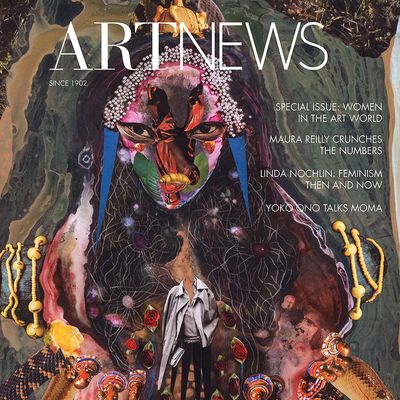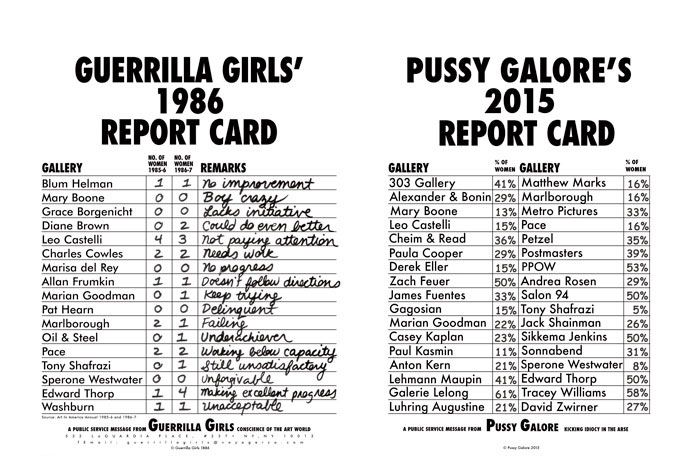
Which blue-chip gallery has an artist roster thatÔÇÖs only 5 percent women? Which European institution devotes only 16 percent of its solo shows to female artists? And which New York museum does barely better than that, with just 20 percent of its shows devoted to female artists?
All these questions are answered within the blisteringly statistics-filled essay by curator Maura Reilly that is the centerpiece of the new ARTnews Women in the Art World issue. ItÔÇÖs a feminist statement laid out calmly and intelligently, with a profile of Yoko Ono and a long section of personal essays by female artists rounding out the shocking revelations in the graphs and figures.
But how did it all come together, and what effect will it have on the testosterone-washed art world? We spoke on the phone with ARTnews editor Sarah Douglas and Reilly, who acted as a guest contributing editor of the issue, about the strides theyÔÇÖve made and what they have to do moving forward.
Sarah, when did you first have the idea to do a women-only issue? What were your initial reasons for being enthusiastic about it?
Sarah Douglas: Maura reached out to me, this was last fall. ItÔÇÖs to ARTnewsÔÇÖ credit ÔÇö and you might even call it an interesting nod to feminism ÔÇö that they hired me in this job when I was, I think, seven and a half months pregnant. I started in July, I went on my maternity leave in August, had my first child. So when Maura called me, it was really on my mind: the question of, what would change for me as a woman working in the art world when I had a child?
Maura Reilly: IÔÇÖve been lecturing about this for years, using all these statistics and these graphs and putting them out there, and everyone says, ÔÇ£Oh my God, I want a copy of those graphs, oh my God, I want those statistics.ÔÇØ TheyÔÇÖre so horrible. ItÔÇÖs so horrible for women, we need to get that information out there. And thatÔÇÖs kind of how it came about ÔÇö I didnÔÇÖt want it to just be a lecture anymore, I wanted to really get it into print and into a major magazine and to open up a much larger discussion because thatÔÇÖs the only way weÔÇÖre really going to precipitate change in the long run.
Douglas: We went back to 1971, when ARTnews published the now-famous Linda Nochlin essay, ÔÇ£Why Have There Been No Great Women Artists?ÔÇØ And she meant it as a real question. YouÔÇÖll see in our current issue she talks about how she came up with that question. What ARTnews did is they went to artists and they said, how would you answer this? As a woman artist? Why are there no great women artists? And that is what was so great about that. And so we said, LetÔÇÖs re-create that format but letÔÇÖs take the things youÔÇÖve been giving as a keynote, letÔÇÖs turn it into an essay. And we made it into an essay and we showed it to these women artists who are doing amazing work now, like Mickalene Thomas and Cindy Sherman. It becomes a conversation where you sort of have Maura talking about the sort of hard numbers, the quantitative, and then you have these artists kind of taking on the qualitative, their experiences.
Reilly: In the actual issue that weÔÇÖve put out here, you finally get the story of how Linda came up with that initial question in 1971. I think thatÔÇÖs so critical that she was actually at a graduation address up at Vassar, and Gloria Steinem was speaking, and Richard Feigen turned to her and said, ÔÇ£You know, IÔÇÖd really love to show women artists, but there just arenÔÇÖt any great ones.ÔÇØ And thatÔÇÖs really interesting because you could say the same thing today. When I go around to galleries and I ask them about their statistics and I throw down the Pussy Galore poster in front of them, they say, ÔÇ£Well, I wish I knew some good women artists.ÔÇØ So, in a way, very little has changed, and thatÔÇÖs what is frightening. A lot has changed, and very little has changed.
Douglas: Not to, like, pull the most obvious pop-cultural reference, but I think what you saw over the last few episodes of Mad Men, I was looking at these women who struggled with self-determination in the workplace at that time and just thinking, like, wow, IÔÇÖm so lucky to live in this time. But then you start to think, well, but there are some things that are still kind of problematic in certain ways, that people think they can say to you, ÔÇ£It happens all the time in the art world as a woman working there.ÔÇØ So I think its just broader discussions, too. ItÔÇÖs about artists, but itÔÇÖs about the whole picture, in a way.
How can you keep pushing things forward from here, then?
Reilly: Keeping awareness up. I mean, also, Nate, you canÔÇÖt underestimate the power of the internet from previous issues. WeÔÇÖll be publishing this all online, which [has] massive potential for influence. But quite honestly, the thing IÔÇÖm most proud of and the thing I think will be fundamentally the most influential ÔÇö and just something that ARTnews can pick up on in a few years by updating ÔÇö are the statistics. You canÔÇÖt deny them. The Guerilla Girls have been doing it. IÔÇÖve been doing it successfully. Numbers donÔÇÖt lie. So when you can put graphs like that into a major magazine, and online, where it can be shared on Facebook a million times, and Twitter, people really ÔÇö itÔÇÖs the most shocking thing when people hear statistics. IÔÇÖve seen people cry. IÔÇÖm not exaggerating. Women coming up to me going, ÔÇ£Oh my God, is it really that bad?ÔÇØ People really think that things are good, that weÔÇÖre really doing okay, and then they hear the statistics for MoMA representations or how little the Tate Modern is showing women, and begin to really decipher those numbers and those stats ÔÇö and itÔÇÖs really glaringly obvious that the sexism is still so woven into the fabric, the cultural fabric.

ItÔÇÖs like youÔÇÖre playing to Instagram with this. Right? Someone can Instagram the Pussy Galore Report Card ÔÇö which shows, among other harsh facts, that Sperone WestwaterÔÇÖs artist roster is just 8 percent women ÔÇö and then it starts spreading.
Reilly: When Pussy Galore posted, actually, via me ÔÇö because theyÔÇÖre anonymous ÔÇö they were interviewed by like three or four magazines because it was so influential, and it got like a 1,000 likes, it was crazy, and it went kind of viral.
Douglas: And also, I would just say ÔÇö and I talk about this in the editorÔÇÖs letter ÔÇö whatÔÇÖs interesting about the art world is this specific kind of sphere for this kind of thing. In Hong Kong, the great debate was over whether the art world is a boysÔÇÖ club. And they decided no, itÔÇÖs not a boysÔÇÖ club, in the sense that there are a lot of women working in this field who are formidable women. Think of Barbara Gladstone, Marian Goodman. But this masked the more nuanced problems.
Reilly: The part thatÔÇÖs important is that those women dealers ÔÇö Barbara Gladstone, Marion Goodman ÔÇö are equally sexist in practice. Look at their statistics. What theyÔÇÖre representing as far as women artists is abysmal. Because theyÔÇÖre not even supporting women.
Exactly. If you ask Mary Boone why only 13 percent of her program is women, what is she going to say? How can she defend her sexist attitudes as well?|
Douglas: I also think itÔÇÖs a very, very complicated thing. Maura, you may disagree with me on this. I think we canÔÇÖt entirely blame these art dealers because this is all part of one system. Maybe women in a certain point are not putting themselves forth. So much of the art world is ÔÇö you have to get your work seen, you have to somehow get your work in front of these dealers.
Reilly: Everything is interrelated. WeÔÇÖre talking about the art market press, dealers ÔÇö collectors should be held hugely accountable. They should be demanding a larger representation of women. So itÔÇÖs everybody sort of playing a part in it. What I was just highlighting is that what I find personally disturbing is when women donÔÇÖt support women. ThatÔÇÖs something that I hope comes through in the essay as well. But I would love to hear from Marion Goodman or Mary Boone.
They must have justified to themselves somehow, but I honestly donÔÇÖt know how they can coherently respond when faced with the statistics.
Reilly: YouÔÇÖll love hearing that Pussy Galore told me that after they put the post out, that they got these angry emails from people like Metro Pictures, and a couple other places, that they were off from like 2 percent.
Douglas: By the way, we double-checked that.
Reilly: So, yes, it can be influential. Because all of a sudden the gallery says, ÔÇ£Oh my God, IÔÇÖm on a poster, we donÔÇÖt look so good.ÔÇØ Maybe they will add a woman artist the next year. That would be the ideal thing.

